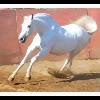Sooty/Pangare Discussion
Forums
Your first nine pictures are
Your first nine pictures are of brown/brown-based horses, which is something that, in my opinion, is completely unrelated to a 'sooty' gene and rather an agouti mutation trait. Brown causes the soft spots (muzzle, armpits, flank, belly) to be lighter/red. The 10th picture is a chestnut with pangare and is not what I would call sooty. Pangare lightens/dilutes the soft spots rather than darkening the rest of the body. You can see it on both chestnuts and bays (any horse with red pigment). I would call the last picture sooty. I am actually starting to question if there really is even 'sooty' on bay horses or if it is all really brown variations. Sooty might just only show up on red-based.
Oh, the chestnut and buckskin
Oh, the chestnut and buckskin filly are all examples I sumbitted and were put in the "sooty" photo gallery... I knew she had pangare, btw, I think they were saying her mane, etc is from sooty maybe...
And MP, what of the counter shading on the buckskin colt I posted (with the dark bay colt). Is that not sooty causing it or what is your opinion on that?
This one
[img]http://a1.sphotos.ak.fbcdn.net/hphotos-…]
Do you consider this from brown?
http://equine.colorgenetics.info/galler…
I think sooty is entirely
I think sooty is entirely possible on bay bases. Just more difficult to verify because of the existence of brown.
These two buckskins really make me think they have sooty.
[IMG]http://i872.photobucket.com/albums/ab28…]
[IMG]http://i872.photobucket.com/albums/ab28…]
Website with more pics of the last guy: http://picasaweb.google.com/11001233847…
I think I first heard that
I [i]think[/i] I first heard that Sooty behaves differently based on color from Sponenburg. I don't recall if it was in a book, or in an email response. If it was email, it was some time ago. However as an artist, when I look for photo references, I have noticed this difference when you compare a sooty chestnut to a sooty bay. And for all we know, the two reactions could be due to different genes.
These are some Chestnut Base horses which I feel represent Sooty moving 'up' the body.
http://www.ultimatehorsesite.com/images…
http://3.bp.blogspot.com/_Cs6T3wiLyhA/T…
http://www.solaris-sport-horses.co.uk/i…
http://www.fossilgatefarms.com/PhotoAlb… Now for him, you can see the sooty in his mane as well. But also that the sooty doesn't look like it originated on the horses top line, but on the legs and worked up.
http://i279.photobucket.com/albums/kk15… while this one is pretty much covered, you can see the concentration on the front legs clearly.
http://morgancolors.com/heathermoorgold… and this one is a palomino, but sooty behaves differently here. No dapples for starters. You can still see the concentration in the legs, eventually covering the entire body.
http://www.hilldalefarm.com/chexnujewel… and http://i279.photobucket.com/albums/kk15… are examples of sooty not following 'rules' if there are rules.
http://a34.idata.over-blog.com/0/23/47/… this is a darker shade of palomino, with sooty or counter shading, what ever you wish to call it, concentrated on the legs, going up the hip and shoulder, but not coming from the top line.
I've seen the same patterns on Sooty Chestnuts, where sooty could be in the mane and tail, or on the body.
I've also seen a difference in sooty chestnuts, what what I call Liver Chestnuts (who don't seem to be effected by sooty), and I wondered if Shade of a horse had anything to do with the intensity of sooty. It really is complicated, and the more I start to question and wonder, the more I wonder if 'sooty' is going to be another umbrella term. Like an description of an effect, and not so much the name of a possible gene.
sooty tends to settle lower
Sooty tends to settle lower and work its way up on red bases while it is suspected to affect the topline down on bay bases.
It also can affect manes and tails. I've seen confirmed palis who you could mistake as silver buckskins due to the mane tail and lower legs being affected. And then you have Holiday Compadre the confirmed chestnut morgan who looks bay.
[IMG]http://i872.photobucket.com/albums/ab28…]
EDIT: I pretty much think sooty already is an umbrella term for any addition of black pigment. The varied expressions kind of lend it to likely being polygenic.
Threnody- I would call both
Threnody- I would call both your buckskins brown-based buckskin.
I think sooty on reds causes dark from the legs up and in the mane and tail. My palomino Welsh has almost black inner legs (where you can see the leg above his high chrome) and the darker gold palomino color on the outside of the hocks. He also has black hairs in his mane and tail. His topline is pale palomino color.
That's why I said they make
That's why I said they make it appear possible. The placement of black on the head seems strange for brown. I sure as heck wish I could get them tested for it.
Holiday Compadre is advertised as a dark chestnut. http://www.morgandressage.org/stalliona…
I'm emailing his owners to get confirmation. Considering he's a morgan and they're infamous for extreme sooty expression it's not unbelievable compared to all the chocolate and 'black' palominos we've seen from the breed. But if it's misinformation I'll let you know. :-)
Got a reply.Yes, Compadre is
Got a reply.
[i]Yes, Compadre is a chestnut. Morgans tend to have very dark base colors. He has not been tested for color but it is very, very clear having him here that he is. At age 24, he is still a remarkable horse and seems quite content with his sons on either side of him and his ladies across the aisle. He has access to his own paddock 24/7 and just enjoys his life.[/i]
[i]Thanks so much for your email. Compadre is a delight every day.[/i]
I'm thinking that the images posted on the internet may have the contrast increased or he is just that dark. Its also possible that he has 'makeup' around his nose and eyes to accentuate the head like what is done in arabs.
TheSwingHorse wrote:Oh, the
[quote=TheSwingHorse]Oh, the chestnut and buckskin filly are all examples I sumbitted and were put in the "sooty" photo gallery... I knew she had pangare, btw, I think they were saying her mane, etc is from sooty maybe...
And MP, what of the counter shading on the buckskin colt I posted (with the dark bay colt). Is that not sooty causing it or what is your opinion on that?
This one
[img]http://a1.sphotos.ak.fbcdn.net/hphotos-…]
Do you consider this from brown?
http://equine.colorgenetics.info/galler…]
MP, I'm still interested to know what you think is causing the lighter buckskin's counter shading... :( Now I'm all flustered about sooty! lol
I just wanted to jump in here
I just wanted to jump in here and say that it is my opinion that it is from brown. The sooty album probably needs to be redone as most of those photos were added before the brown test came out and so at the time they were thought to be bay with sooty rather than brown.
It's just so difficult to say for sure as the brown test still isn't utilized all that much. So, we still don't have much of a base of tested horses to compare.
I think they are all sooty.
I think they are all sooty. The chestnut mare is in our albums as sooty, pangare and flaxen. There is nothing else (I can think of) that would cause a silver mane on such a horse, along with the slightly darkened aspect of her coat. She is not the typical clear coated or golden chestnut of a flaxen. We see it in Welshes all the time, and there are some infamous examples of sooty manes and tails only in other horses. To me, that is a really obvious sooty example. Sooty is defined only as a darkening of the coat in some respect. There is no known genetic aspect to be pinned down. So essentially, if it looks like sooty then it is sooty. We can only speculate on causes. It's like splash. The pattern is its own definition. It could be something else or a mixture of spotting patterns. But if it looks like splash, then it is splash. If it causes a darkening of the coat, then it is sooty because that is the definition.
And if this is brown... Is
And if this is brown...
[img]http://a4.sphotos.ak.fbcdn.net/hphotos-…]
Is this also brown but very minimally or would it be considered excessive?
[img]http://a8.sphotos.ak.fbcdn.net/hphotos-…]
Or is it just "light brown" vs "dark brown" like a light bay vs dark bay?
"My question is, does the
"My question is, does the brown base cause the fake dorsal stripe he has?"
I don't think Brown would cause that. What would lead you to think that it wasn't a type of sooty causing that kind of counter shading?
I thought there was a document floating around of horses that did test positive for Brown. When i attended a lecture a few years ago, I don't think the Brown test had been out for year yet. But I remember the speaking saying that some browns looked typical bay, and some browns looked almost black. Now who's to say that's just shade control for you, or if there are sooty genes at play.
I don't know anything about
I don't know anything about it based on genetic study, or looking at hairs and what have you. But I'm leaning more towards there not being a single type of sooty. From what I can see, it varies on breeds, on base colors, and even varies on how it interacts with the rest of the horses body. Just like I don't think that is one Dun.
I am in agreement with
I am in agreement with JNFerrigno on sooty. I think that there is a sooty that appears on ee horses that cause the darkening from the bottom up plus some mane and tail effect. Then you have the sooty that is seen so much in Morgans that is just super, super dark overall, which may or may not be related to the one I mentioned before. I think a lot of what we call sooty on bay-based horses is actually now brown (At) at work. Countershading is something else too, which could be mimicking primitive markings or maybe there is some mutation that is keeping foal primitive markings from fading as adults. And then what causes the random dark patches that we call Bend Ors? At this point, like Maigray said, we don't really know and are just trying to place some semblance of order into the chaos that is coat colors. Just like we used to call everything that wasn't a tobiano an overo, but now we say DW, sabino, frame, rabicano and splash, I think that there is probably more going than the catch all of sooty for any dark areas on a horse.







When I think of sooty I think
When I think of sooty I think of dark "shading" over the withers/topline.